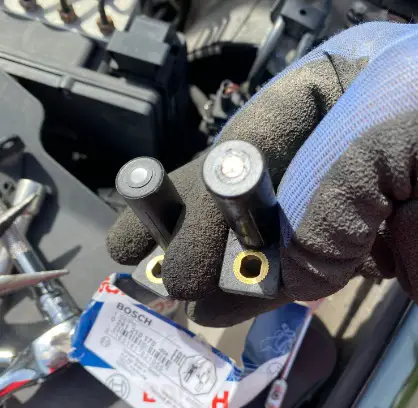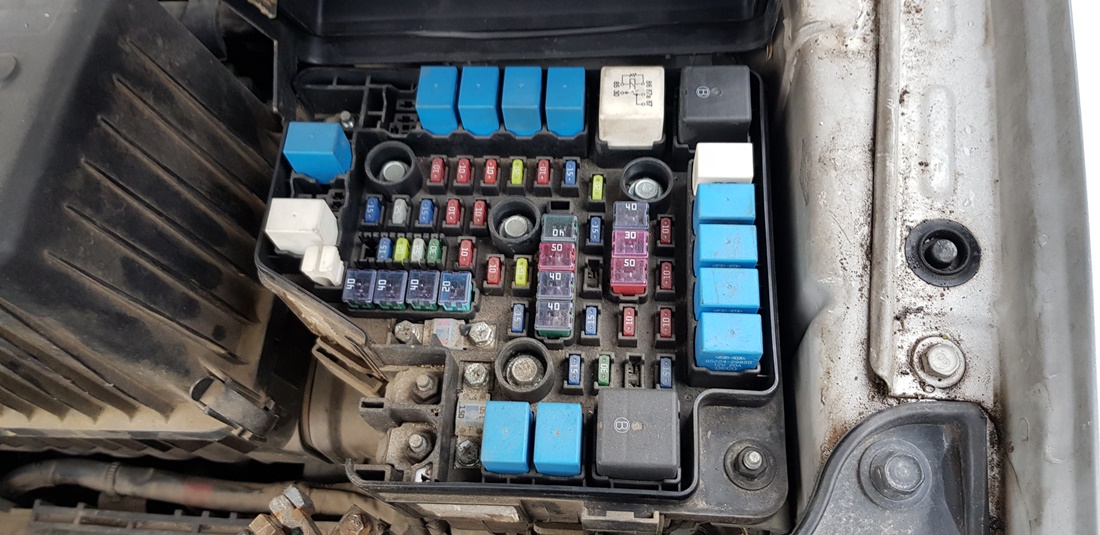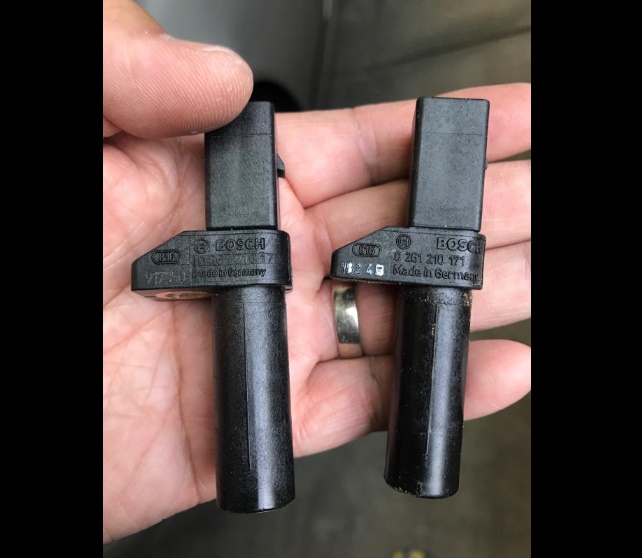If the overdrive light on your Ford Explorer is flashing, it could indicate an issue with the system. This can be due to low transmission fluid or a clogged filter.
In this blog post, we’ll look into the causes and solutions to this issue. Additionally, we’ll explain what to do if your Ford Explorer overdrive light continues flashing after you have resolved the underlying cause.
The most common causes of why the overdrive light is flashing on your Ford Explorer are low transmission fluid, dirty transmission oil filter, damaged overdrive sensors or switch, and an issue with the overdrive solenoid.
- Key Takeaway
- Why Is My Overdrive Light Flashing On My Ford Explorer?
- How Do You Turn Off Overdrive On a Ford Explorer?
- Is It OK To Drive With Overdrive Off?
- FAQs
- Q: What should I do if my overdrive light is flashing?
- Q: Can I continue driving with the overdrive light flashing?
- Q: How much does it cost to fix a flashing overdrive light on a Ford Explorer?
- Q: Can I fix the flashing overdrive light myself?
- Q: What are some common causes of a flashing overdrive light?
- Q: How do I check the transmission fluid level on my Ford Explorer?
- Q: Is it safe to drive with a low transmission fluid level?
- Q: What should I do if my Ford Explorer is overheating?
- Q: How can I prevent transmission problems on my Ford Explorer?
- In Conclusion
Key Takeaway
- The overdrive light on your Ford Explorer might be flashing due to a problem with the transmission, such as low or dirty transmission fluid, and it acts similarly to a ‘check engine’ light, indicating that a diagnostic check is needed.
- While it’s generally safe to drive with overdrive off, doing so may lead to higher fuel consumption and engine wear at high speeds, as it disables the highest gear in your car’s transmission designed for efficient cruising at sustained speed.
Why Is My Overdrive Light Flashing On My Ford Explorer?

- Low transmission fluid
- Dirty transmission oil filter
- Faulty overdrive transmission sensors
- Faulty overdrive switch
- A problem with the overdrive solenoid
An overdrive light on a Ford Explorer is an indication that the vehicle’s overdrive system may be malfunctioning.
When this light illuminates, it means there’s something wrong with the transmission; ignoring this problem could result in damage to other components as well.
Here are some common reasons why an overdrive light might flash on a Ford Explorer:
1. Low transmission fluid

Transmission fluid serves to lubricate and cool the transmission, as well as power its hydraulic components.
Overdrive is an additional gear that helps reduce engine speed while improving fuel economy while driving at highway speeds. Together, these features enable your car to run more efficiently.
Low transmission fluid levels in your car can cause the overdrive to malfunction. The overdrive relies on the transmission fluid for proper functioning, and without enough of it, the overdrive may slip or not engage at all – a serious issue when driving at high speeds on the highway where overdrive helps maintain speed.
Before driving long distances, always check your transmission fluid levels. If you notice that your overdrive is failing, immediately add more transmission fluid and prevent further damage to the transmission of your vehicle. Failure to do so could prove costly in the long run.
If your car’s transmission or overdrive is malfunctioning, it’s essential to get it checked out by a mechanic right away.
These intricate systems can be expensive to repair if something goes awry; however, with regular upkeep and care, you can help ensure your transmission stays in optimal working order for many years into the future.
2. Dirty transmission oil filter

Transmission oil filters help remove contaminants from transmission fluid, keeping it clean and free of debris that could clog the transmission and lead to problems. They also catch any metal shavings or other particles that could harm the transmission.
It is recommended that transmission oil filters be changed regularly as part of routine vehicle maintenance to keep your vehicle running optimally.
A primary sign of a dirty transmission oil filter is gear shifting issues. The transmission may not shift into the correct gear or slip out while driving, due to debris and sludge accumulation within the fluid.
These issues can arise due to improper maintenance or lack of power when shifting gears.
If you experience any issues with your transmission, such as gear slippage or noises, it’s essential to have it assessed by a professional.
These could be signs that the oil filter needs replacing; an old or dirty filter can cause extensive damage and even lead to the complete failure of the gearbox. Replacing this filter is usually easy and inexpensive – don’t wait!
3. Faulty overdrive transmission sensors

Overdrive transmission sensors are designed to monitor the operation of an overdrive transmission system and give feedback to the engine control unit. By measuring speed and position, these sensors can optimize engine performance and fuel economy.
Furthermore, overdrive transmission sensors help prevent damage to the overdrive system by giving early warning of potential issues.
Overall, overdrive transmission sensors play a vital role in keeping your vehicle’s overdrive system functioning optimally.
If you suspect there may be an issue with your sensor, seek professional assistance immediately; neglecting to check it could result in serious damage to the overdrive system.
An overdrive sensor is an integral component of a car’s transmission, and when it malfunctions, the car won’t be able to shift gears properly.
This could result in decreased fuel economy and increased wear on both engine and transmission components; in extreme cases, it may even cause your vehicle to stall or come to a complete halt.
If you suspect your overdrive sensor has gone bad, make sure it gets checked by an experienced mechanic immediately.
How to fix a failed overdrive sensor
If your overdrive sensor has malfunctioned, there are a few steps you can take to try and resolve the problem.
Check your fuse box for any blown fuses; if none exist, then you may need to replace the overdrive sensor itself.
These can usually be found at auto parts stores or ordered directly from the manufacturer of your car.
Once you replace the overdrive sensor, it is essential to have your car’s transmission checked by a qualified mechanic.
This will guarantee that the new sensor functions correctly and that there are no other issues with the gearbox.
With proper care and upkeep, your car should be able to shift gears smoothly for many years into the future.
4. Faulty overdrive switch

The overdrive switch is used to engage the transmission’s overdrive gear, usually fourth. This higher ratio reduces engine speed and helps improve fuel economy.
If there are issues shifting into overdrive, the switch may temporarily disable this function as well.
In certain instances, activating the overdrive switch may also cause the transmission to downshift into a lower gear if it detects that you are driving at high speed or under heavy load conditions.
If a transmission overdrive switch malfunctions, it can cause the vehicle to shift gears abruptly – potentially dangerous if traveling at high speeds.
If you suspect that your transmission overdrive switch has gone bad, take your car immediately to an experienced mechanic for diagnosis and repairs. Neglecting such issues now could lead to larger problems in the future.
Have you ever wondered what that small “OD” switch on your dash meant? It stands for “overdrive.” Nowadays, most cars and trucks come equipped with overdrive transmissions – meaning they have four forward gears instead of the traditional three.
When your vehicle reaches highway speeds, this gear typically engages to reduce engine noise and enhance fuel economy.
The transmission overdrive switch is typically a push-button design and is located near the shifter. Pressing it will engage the overdrive gear while holding it down will disable it. Some vehicles also have an illuminated indicator light to indicate when this feature has been engaged.
5. A problem with the overdrive solenoid

The overdrive solenoid is responsible for activating the vehicle’s overdrive gear. When activated, it allows the transmission to shift into a higher gear ratio which helps improve fuel economy and reduce engine wear.
Typically controlled by your car’s computer system, however, it can also be manually operated if desired.
When a transmission overdrive solenoid fails, it can cause the transmission to shift erratically or not shift at all. This could result in engine damage and/or reduced fuel economy; in extreme cases, complete rebuilding may be required.
Since transmission overdrive solenoids play such an important role in vehicle performance, having them checked regularly by an experienced technician is recommended. If you suspect your overdrive solenoid may be malfunctioning, contact us right away for diagnosis and advice on repairs.
How Do You Turn Off Overdrive On a Ford Explorer?
To turn off overdrive on a Ford Explorer, you need to press the OD off button usually located at the end of the shifter stick.
The overdrive button is located on the steering column, just below the turn signal lever. Pressing this button disengages the overdrive gear, allowing your vehicle to shift into lower gear ranges – ideal for hilly or mountainous terrain.
Is It OK To Drive With Overdrive Off?
Yes, it is generally safe to drive with overdrive off, especially when towing or driving on steep inclines, as it can prevent unnecessary damage to the transmission, but it may lead to higher fuel consumption and engine RPM at high speeds.
Transmission overdrive is commonly used to improve fuel economy. By decreasing engine speed and running the transmission at a higher gear, less fuel is consumed – especially during long trips or extended usage. Furthermore, transmission overdrive helps extend engine life by reducing wear and tear on components.
Another popular application of transmission overdrive is to enhance vehicle performance. By increasing the transmission ratio, more power is sent to the wheels which can result in improved acceleration – ideal for racing or other times when maximum performance is desired.
Furthermore, transmission overdrive helps reduce stress on other drivetrain components like the engine and differential by providing extra torque at higher RPMs.
In some circumstances, you may need to drive with the overdrive turned off. But is this safe? Generally, yes. Disabling the overdrive won’t decrease gas mileage much and gives you less control over speed; driving too quickly could even damage the engine if done incorrectly says CarTalk.
FAQs
Q: What should I do if my overdrive light is flashing?
A: If your overdrive light is flashing, it is recommended to have your vehicle inspected by a qualified mechanic as soon as possible. They will be able to diagnose the specific issue and recommend the necessary repairs.
Q: Can I continue driving with the overdrive light flashing?
A: It is usually not recommended to continue driving with the overdrive light flashing, as it can potentially lead to further damage to the transmission. It is best to have the problem addressed by a professional before continuing to use the vehicle.
Q: How much does it cost to fix a flashing overdrive light on a Ford Explorer?
A: The cost of fixing a flashing overdrive light on a Ford Explorer can vary depending on the specific issue causing the problem and the labor rates in your area. It is best to consult with a mechanic for an accurate estimate.
Q: Can I fix the flashing overdrive light myself?
A: Unless you have experience and knowledge in transmission repairs, it is generally not recommended to attempt fixing the flashing overdrive light yourself. The transmission system is complex and requires specialized equipment and expertise to diagnose and repair.
Q: What are some common causes of a flashing overdrive light?
A: Some common causes of a flashing overdrive light on a Ford Explorer include low transmission fluid, a failed speed sensor, a faulty solenoid pack, or a malfunctioning tcc (torque converter clutch) solenoid.
Q: How do I check the transmission fluid level on my Ford Explorer?
A: To check the transmission fluid level on a Ford Explorer, start the engine and let it warm up. Then, park the vehicle on a level surface, engage the parking brake, and shift through each gear before returning to park.
Locate the transmission dipstick, typically found near the back of the engine bay, and remove it. Wipe it clean, reinsert it, and then remove it again to check the fluid level. The correct level should be within the designated range on the dipstick.
Q: Is it safe to drive with a low transmission fluid level?
A: Driving with a low transmission fluid level can cause damage to the transmission and lead to costly repairs. It is important to check the fluid level regularly and top it up if necessary to ensure proper lubrication and cooling of the transmission components.
Q: What should I do if my Ford Explorer is overheating?
A: If your Ford Explorer is overheating, it is important to stop the vehicle as soon as it is safe to do so and turn off the engine. Allow the engine to cool down before attempting to diagnose the cause of the overheating. This could be due to issues such as a malfunctioning thermostat, a coolant leak, a faulty radiator, or a malfunctioning water pump. It is recommended to have the vehicle inspected by a professional to avoid further damage.
Q: How can I prevent transmission problems on my Ford Explorer?
A: Regular maintenance, such as keeping up with fluid changes and having the transmission inspected periodically, can help prevent transmission problems. Additionally, driving responsibly and avoiding excessive towing or hauling can also help prolong the life of the transmission.
In Conclusion
The overdrive light on your Ford Explorer may flash as an indication of issues with the transmission.
These problems can range from low or dirty transmission fluid to a shorted Electronic Pressure Controller or even a defective sensor.
The blinking light is akin to the “check engine” light, signaling that there’s a problem requiring attention.




